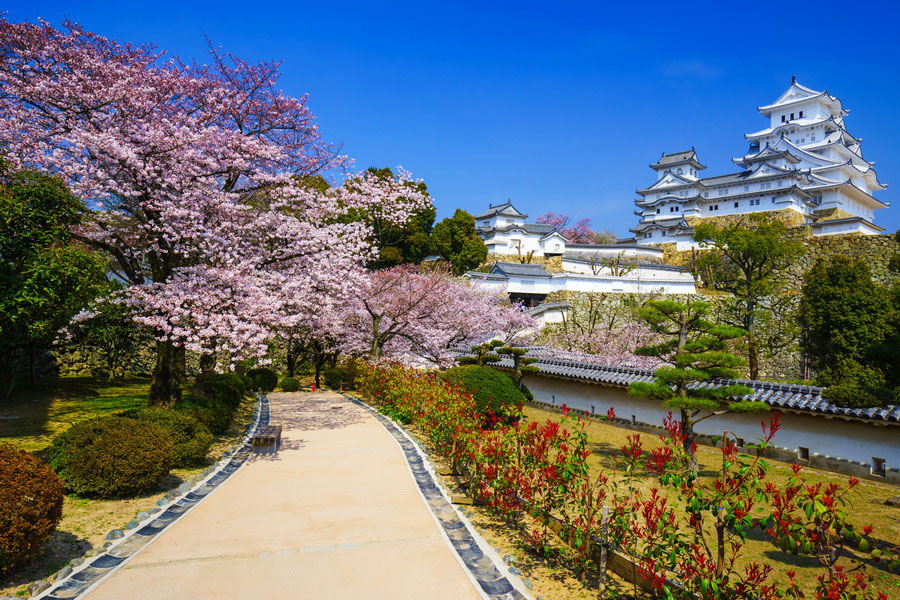The history of Japan is a vivid tapestry of dynasties, shifting capitals, eras of peace, and times of war, marked by periods when the country turned inward in near isolation or opened its doors to active engagement with the wider world.
Human presence in the Japanese archipelago dates back over 30,000 years, long before the emergence of a distinctly Japanese civilization. Over the centuries, Japan evolved from its ancient roots (before the 8th century) through the Classical period (8th–12th centuries) and the Medieval era (12th–16th centuries), into the Early Modern period (17th–19th centuries), and finally entered the modern age in the latter half of the 19th century. Each era is divided into notable periods, among them the Nara (710–794), the Heian period (平安時代, 794–1185), the Edo period (江戸時代, 1603–1868), and the Meiji period (明治時代, 1868–1912).
Ancient Japan (Early Japan, ~35,000 BC – 710 AD)
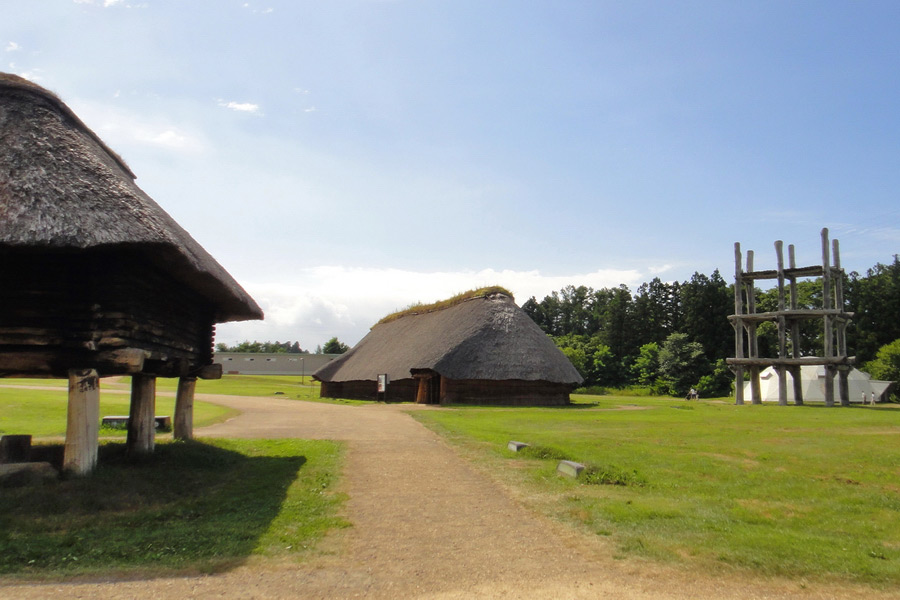
Human settlement of the Japanese archipelago dates back at least 35,000 years, to the Paleolithic era (旧石器時代). During this time, small groups of hunter-gatherers inhabited what is now Japan, living without agriculture, pottery, or domesticated animals. Rice - which would later become a central part of Japanese culture - was not cultivated until much later, arriving with the spread of wet-rice farming during the early Yayoi period around 900–400 BC.
The earliest material evidence of a distinct cultural tradition in Japan dates to around 14,000 BC, marked by the appearance of some of the world’s oldest pottery. This innovation signals the start of the Jomon period (縄文時代, approximately 14,000 BC – 300 BC), a long era characterized by hunter-gatherer communities who gradually adopted more sedentary lifestyles.
Following this was the Yayoi period (弥生時代, approximately 300 BC – 250 AD), notable for the introduction of agriculture, metalworking, and social hierarchies. From the 3rd century AD, the Kofun period (古墳時代, 250–538 AD) began, distinguished by the construction of large burial mounds for elite figures. This evolved into the Asuka period (飛鳥時代, 538–710 AD), a transformative era that saw the arrival of Buddhism and the first significant steps toward a unified state under imperial rule.
Jomon period (縄文時代, approx. 14,000–300 BCE)
During this period, the foundations of culture and religion were laid, and unique pottery traditionsemerged. People built small settlements where they lived together in groups. The total population of Japan during the Jomon period is estimated to have ranged between 20,000 and 100,000 people. Most of the surviving archaeological sites from prehistoric Japan are found in the northern prefectures, particularly Aomori and Hokkaido, and many have been recognized on the UNESCO World Heritage list. The largest of these is the Sannai Maruyama site (三内丸山遺跡) in Aomori, which supported a community of about 500 people and existed for roughly 1,500 years (from 3,500 to 2,000 BC).
During this time, the groundwork was laid for many uniquely Japanese concepts, including the tradition of imperial rule. When asked the difficult question of when Japan was founded, many Japanese people will answer with February 11, 660 BC. This date is traditionally regarded as the time when the legendary first emperor of Japan, Jimmu (711–585 BC), ascended the throne. Jimmu is said to have been a descendant of Amaterasu, the sun goddess and one of the most important deities in the Shinto pantheon. This founding is so deeply revered that February 11 is still celebrated in Japan as a national holiday. Thus, it is believed that in 660 BC the Japanese imperial dynasty, which continues to this day, was established. Over more than 2,500 years, Japan has had 125 emperors, with the current 126th Emperor, Naruhito (徳仁, born in 1960), recognized as a direct descendant of Emperor Jimmu.
Yayoi period (弥生時代, approximately 300 BC – 250 AD)
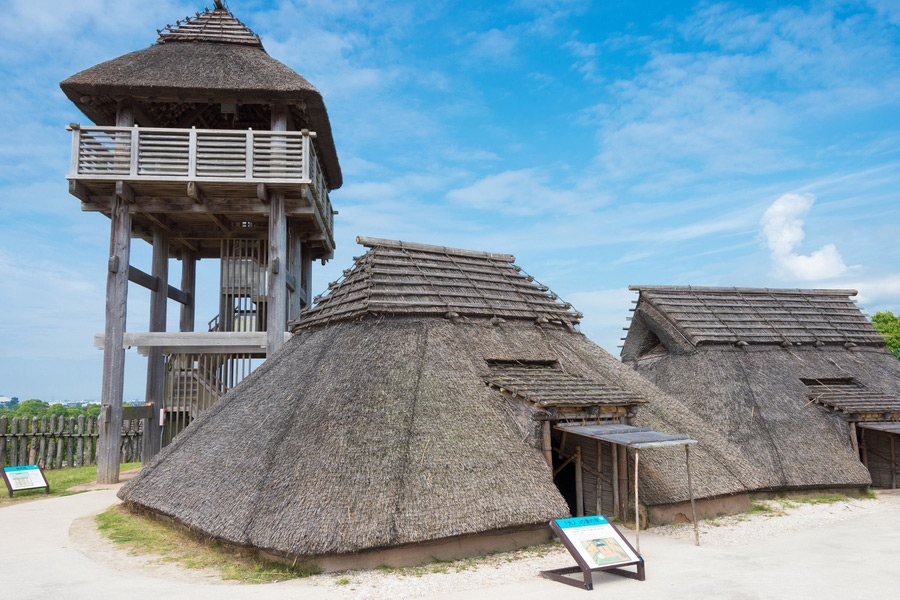
The Yayoi period was marked by significant migration into Japan by people from the Korean Peninsula and, more indirectly, from regions of China. This era saw a major technological breakthrough with the introduction of metalworking, the potter’s wheel, and the loom, which transformed daily life and craftsmanship. Religious beliefs also evolved notably during this time, with the establishment of the first sacred sites dedicated to worshiping Shinto deities (kami) – marking the early formation and growth of Shintoism.
People of the Yayoi period began to live in larger, often fortified settlements, which offered protection against potential attacks. One of the most renowned examples is the Yoshinogari site (吉野ヶ里遺跡), located in Kanzaki City (神埼市), Saga Prefecture (佐賀県). Dating back over 2,200 years, it stands as one of Japan’s most important archaeological sites and provides valuable insight into Yayoi-era society.
Yamato period (大和時代, approximately 250–710)
During this time, Japan saw the rise of its first recognizable state formation, the Yamato polity (ヤマト王権), which gave its name to the entire era. The country’s culture was deeply influenced by Chinese imports in areas such as technology, political systems, urban planning, and religion. It was also during the Yamato period, in the mid-6th century AD, that Buddhism was introduced to Japan – an event that marked a crucial turning point in the history of Japanese religion.
Prince Shotoku (聖徳太子, 574–622), who lived during the Asuka period and was part of the powerful Soga clan (蘇我氏), played a key role in shaping Japanese statehood. Though officially regent to his aunt, Empress Suiko (推古天皇, 554–628), who reigned at the time, Shotoku made significant contributions to Japan’s political framework. He adopted Chinese models of state administration, introduced the Twelve Level Cap and Rank System (冠位十二階), and carried out many other reforms aimed largely at strengthening Buddhism’s position in Japan.
In 646, under Emperor Kotoku (孝徳天皇, 596–654), sweeping changes known as the Taika Reform (大化の改新), or “Great Change,” were launched. These reforms transformed the central government and overhauled land ownership and taxation systems. They laid the groundwork for the Taiho Code (大宝律令), compiled in 701, a comprehensive legal code that governed Japanese society and remained the primary set of laws until the adoption of the Meiji Constitution in 1889.
Ancient history of Japan – Interesting Facts
- Japan was once physically connected to the Eurasian mainland. It only became separated due to melting glaciers and rising sea levels about 10,000 to 14,000 years ago. It is difficult to imagine, but in those distant times, people could reach Japan on foot either from the Korean Peninsula in the south or from Sakhalin Island in the north.
- Ceramic vessels discovered in Japan and dating back to the Jomon period are the oldest known pottery in the world. Interestingly, the entire period takes its name from this pottery, which featured a distinctive pattern resembling twisted rope – hence the term “Jomon” (縄文), meaning “rope pattern”.
- The main ethnic group in modern Japan is the Yamato (大和民族), whose features resemble those of other East Asian populations. However, few people realize that they are not the original inhabitants of Japan. Long before their arrival, around 14,000 BC, the Ainu (アイヌ) lived on the northern islands. They had a markedly different appearance, often described as more similar to certain European groups. It was the Ainu who developed the unique Jomon culture, and after the emergence of the Yamato people, they were frequently in conflict. Over time, the small Ainu population was almost entirely assimilated or marginalized, yet they left a profound mark on Japanese culture and language.
- Japan is also home to remarkable sights known as megaliths – huge stones and carefully shaped rock structures of mysterious origin and purpose, often dating back to the Jomon period or even earlier. Among the most famous are the Ishi no Hoden (石の宝殿) megalith in Takasago City, and the enigmatic underwater “pyramids” of Yonaguni (与那国島海底地形) near the Ryukyu Islands (琉球諸島).
- Many chapters of Japan’s ancient history remain shrouded in mystery. Surprisingly, there is still a ban on excavating or thoroughly studying the ancient imperial tombs (kofun) in Japan. This restriction was first enacted in 1874 and reaffirmed in 1976.
In his book A Brief History of Japan, Jonathan Clements underscores how much we still do not know, drawing a striking comparison:
“Imagine, for a moment, how different our understanding of China would be without the materials unearthed since 1970 in Chinese grave sites: we would know nothing of the First Emperor's Terracotta Army, nothing of the legal statutes of the Qin, or the unexpurgated Daode Jing, nothing of the military textbooks of Sun Bin”.
Classical Japan (710–1185)
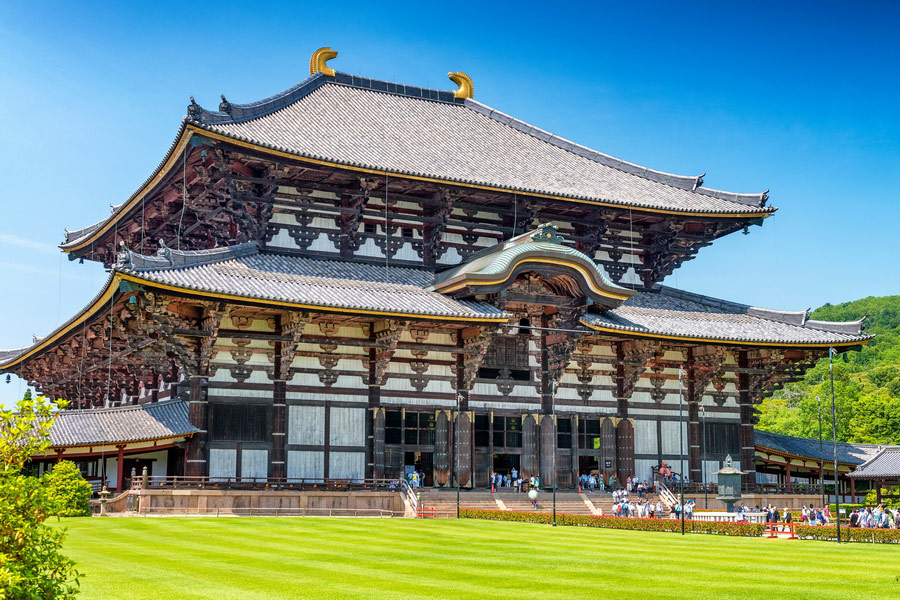
This era typically encompasses the Nara and Heian periods (8th–12th centuries), although some historical periodizations also include the Asuka period, thus extending the start back to the 6th century AD. According to another widely used classification – supported by historian Brett L. Walker, author of the well-known book A Concise History of Japan – this phase is identified as Courtly Japan (710–1185), distinguished from earlier developments. Following this approach, we also draw the line at 710, when the city of Heijō-kyō (平城京), better known today as Nara (奈良市), was established as Japan’s capital.
Nara Period (奈良時代, 710–794)
The city of Nara became the first permanent capital of Japan. Before this, the capital was frequently moved from one location to another after each change of emperor, driven by both political considerations and religious beliefs.
The history of Nara as Japan’s capital began in 710, when it was constructed following the model of the Chinese capital Chang’an. This reflected Japan’s broader orientation at the time toward adopting the political and social structures of Tang Dynasty China (618–907 AD).
Following China’s example, Japan sought to establish a centralized system of government, but these efforts did not fully take hold because of the powerful influence of the hereditary aristocracy, which secured high offices by inheritance rather than professional merit.
The ideological framework of Japan during the Nara period was shaped by a combination of Shinto, Buddhism, and Confucianism. Buddhism, which was already firmly established in the country, exerted a particularly strong influence at this time. The emperors sponsored the construction of numerous Buddhist temples, most notably under Emperor Shomu (聖武天皇, 701–756), during whose reign the grand Todaiji Temple (東大寺, 728) was built. Today, Todaiji is a UNESCO World Heritage Site and is regarded as the largest wooden structure in the world.
By the 8th century, Buddhism had become so deeply rooted that Empress Koken (孝謙天皇, 718–770) and the monk Dokyo (道鏡, 700–772) attempted to establish a Buddhist theocracy, which would have transferred political power to Buddhist institutions. These efforts ultimately failed, and Emperor Konin (光仁天皇, 708–782) later restored the prominence of Shinto.
The Nara period is also notable for the emergence of Japan’s first written texts. The most significant among these are:
- The Nihon Shoki (日本書紀, 720) and Kojiki (古事記, 712), which recount Japan’s history from its earliest legends;
- The Man'yoshu (万葉集, compiled before 759), a celebrated anthology known as the “Collection of Ten Thousand Leaves”, which captures the literary spirit of 8th-century Japan.
Heian Period (平安時代, 794–1185)
At the end of the 8th century, construction began on a new capital city, Heian (平安京), which would give its name to the entire era. Today this city is known as Kyoto (京都市), a place unique in Japanese history, having served as the official capital for over a thousand years, from 794 to 1868.
During the Heian period, power was held not only by the emperor but also by influential aristocratic families, most notably the Fujiwara clan (藤原氏). Throughout the 10th to 12th centuries, members of the Fujiwara family occupied the most important state positions and effectively ruled Japan. The clan’s dominance created a kind of dual system of governance between the emperor and the Fujiwara, and the culture of this time is often referred to as “Fujiwara culture”, highlighting the uniquely Japanese artistic and cultural achievements that emerged as the country moved beyond Chinese influence.
The Heian period is regarded as Japan’s “Golden Age”, when the essence of the national spirit and the foundations of Japanese culture and identity truly took shape. Secular architectural styles flourished, along with music and painting. By this time, the Japanese language had fully replaced Chinese in official and literary use, and Japanese literature emerged and reached its zenith. In the first decade of the 11th century, one of the most important works of Japanese literature was written – “The Tale of Genji” (源氏物語) by the court writer Murasaki Shikibu (紫式部). The character of Genji, somewhat akin to a Japanese Don Juan, embodied the lifestyle and hedonistic ideals of the aristocracy of that period.
Toward the end of the Heian era, a fierce conflict erupted between two powerful clans, the Taira (平氏) and the Minamoto (源). Known as the Genpei War (源平合戦), this struggle lasted from 1180 to 1185 and concluded with the Minamoto clan’s victory. The clan’s leader, Minamoto no Yoritomo (源 頼朝, 1147–1199), established his seat of power in Kamakura (鎌倉市) and assumed the title of “shogun” (将軍), meaning “military ruler”. This event marked the beginning of Japan’s next era – its feudal period.
Interesting facts about the history of Japan in the 8th–12th centuries
- The name “Japan” (“Nihon” (日本)), meaning “origin of the sun” or “where the sun rises in the east”, first appeared in historical records only in the 8th century. It was in 702 that the Japanese ambassador Awata no Mahito (粟田 真人) used this term during a diplomatic mission to China. Before that, the country was generally known by the name Yamato.
- In the 11th century, Japan developed a unique system of government called Insei (院政), which literally translates to “cloistered rule” or “government by retired emperors.” During this time, emperors would formally abdicate the throne and retire to monastic life, yet continue to wield significant political power behind the scenes. The official ruler would be their heir, often still a minor, while the retired emperor effectively governed the country.
- Japan’s own writing system, which laid the groundwork for a rich and distinctive culture and literature, was created only in the 9th century, during the Heian period. It was then that the syllabary gojūon (五十音) was established, along with the development of katakana (片仮名) and hiragana (平仮名) scripts.
- The standards of female beauty in the 9th–12th centuries are also fascinating. Women with pear-shaped faces, small lips, powdered white skin, and blackened teeth (achieved by using a special dye called ohaguro) were considered the height of attractiveness. They also shaved off their natural eyebrows and painted high, artificial ones on their foreheads. Fashionable women of this time wore elaborate twelve-layered kimonos (jūnihitoe), a style that took its classic form during the Heian period.
- An intriguing legend surrounds the civil war between the Taira and Minamoto clans. According to this tale, the 12th-century military commander Minamoto no Yoshitsune (源 義経, 1159–1189), one of the war’s key figures, did not actually die but instead fled Japan, traveled to Asia, and assumed the identity of Genghis Khan – later becoming one of the most influential figures in world history. Although there is no evidence to support this theory, it remained popular in Japan for many years, especially given that Genghis Khan was nearly the same age as Yoshitsune.
Medieval or Feudal Japan (1185–1603)
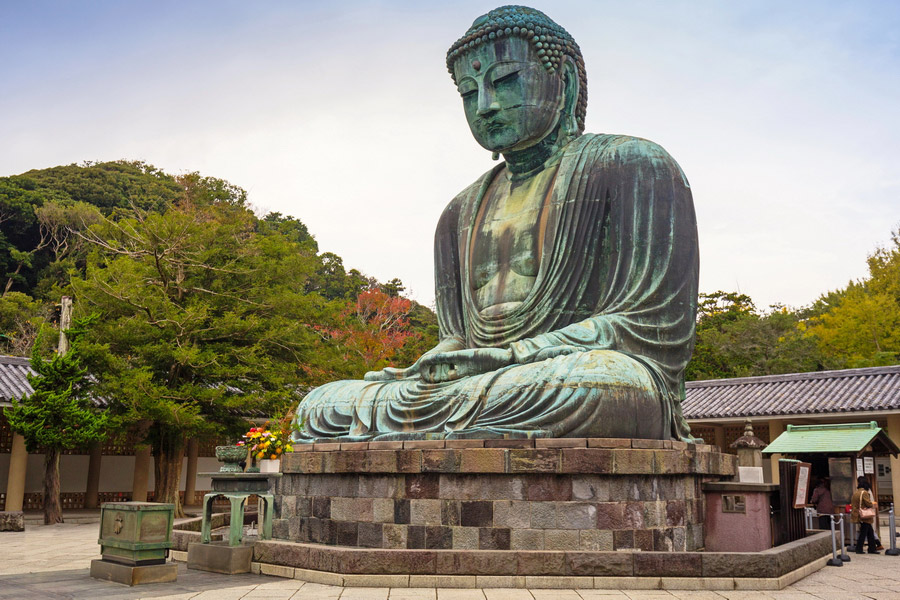
This era covers Japan’s long and often turbulent development from the 12th to the 19th century, spanning the Kamakura, Muromachi, and Edo periods.
Kamakura Period (鎌倉時代, 1185–1333)
The period of Japanese history up to 1333 is known as the Kamakura period, named after the coastal city in eastern Japan that served as the center of the shogunate established by Minamoto no Yoritomo. During this era, a system of dual authority was formally instituted in Japan: on one side stood the military leader, the shogun, while on the other remained the emperor, whose power, though not abolished, became largely ceremonial.
The Kamakura shogunate was the first of three shogunal governments in Japanese history. This military-centered political structure provided fertile ground for the emergence and flourishing of samurai warrior culture, which had its roots as early as the 7th century, but only rose to prominence as Japan’s dominant military class in the 12th century.
Beyond its military focus, the Kamakura period also saw significant developments in culture, art, and architecture. One of the most iconic surviving monuments from this time is the Kotoku-in (高徳院) temple, renowned for its massive bronze statue of Buddha.
During this period, internal conflicts and political fragmentation grew more intense. The era was also marked by two failed attempts by the Mongols under Kublai Khan (1215–1294) to invade Japan, in 1274 and 1281. These invasions, known in Japanese history as the Genko (元寇), ultimately ended in defeat for the Mongols.
After the fall of the Kamakura shogunate, the imperial monarchy was briefly restored in Japan from 1333 to 1336. During this short period, the country was ruled by Emperor Go-Daigo (後醍醐天皇, 1288–1339), remembered for his efforts to revive the social and political order of classical Japan.
Muromachi Period (室町時代, 1336–1603)
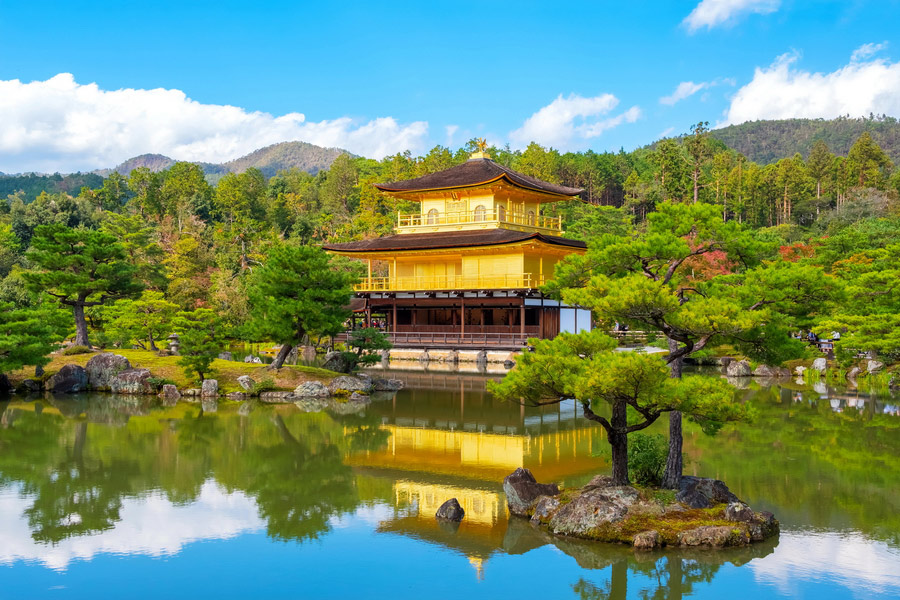
The Muromachi period began amid a struggle for power. Its early phase is known as the Nanboku-cho period (南北朝時代, 1336–1392), or the Period of the Northern and Southern Courts. During this time, real military authority lay with the shoguns of the Ashikaga clan (足利氏), who ruled from the Muromachi district of Kyoto – a location that gave the entire era its name.
Meanwhile, Japan was divided between two rival imperial centers: the Southern Court, based in Yoshino in Nara Prefecture (奈良県), led by Emperor Go-Daigo, who refused to recognize the authority of the shogunate; and the Northern Court (Hokucho, 北朝) in Kyoto, controlled by the Ashikaga shogunate’s appointed emperor and supporters.
As time went on, Japan became even more fragmented, with power largely shifting to regional daimyo (大名) – powerful feudal lords – who engaged in near-constant warfare. This period of intense civil strife is known as the Sengoku period (戦国時代, 1467–1603), meaning the “Age of Warring States”.
The first serious efforts to reunify the country were led by the formidable samurai warlord Oda Nobunaga (織田 信長, 1534–1582). However, full unification was only accomplished by his successor, Tokugawa Ieyasu (徳川 家康, 1543–1616), who established a centralized feudal government in Japan. His rule ushered in the next historical era, known as the Edo period.
Japan and the Great Silk Road (ca. 3rd–16th c. CE)
Japan was an important point along the famous historical Silk Road. As an island nation, Japan participated primarily through the maritime routes of this vast trade network. Active trade began around the 3rd century CE and continued until the end of the 16th century, with a significant interruption of about 300 years during the 9th to 12th centuries.
Through these connections, spices, silk, porcelain, as well as countless crafts, technologies, and even religious ideas flowed into Japan from China and other parts of the continent. It is widely believed that the arrival of Buddhism in Japan in the 6th century CE is directly linked to these Silk Road exchanges.
Japan’s main exports included military goods, such as katana swords and sulfur for gunpowder production. The country also shipped seafood, precious metals, and distinctive handicrafts to overseas markets.
The start of the 17th century in Japan’s history marked a profound change. With the rise of the Tokugawa Shogunate, Japan implemented policies that closed its borders, effectively ending trade with the outside world for more than two centuries.
Edo Period (江戸時代, 1603–1868)
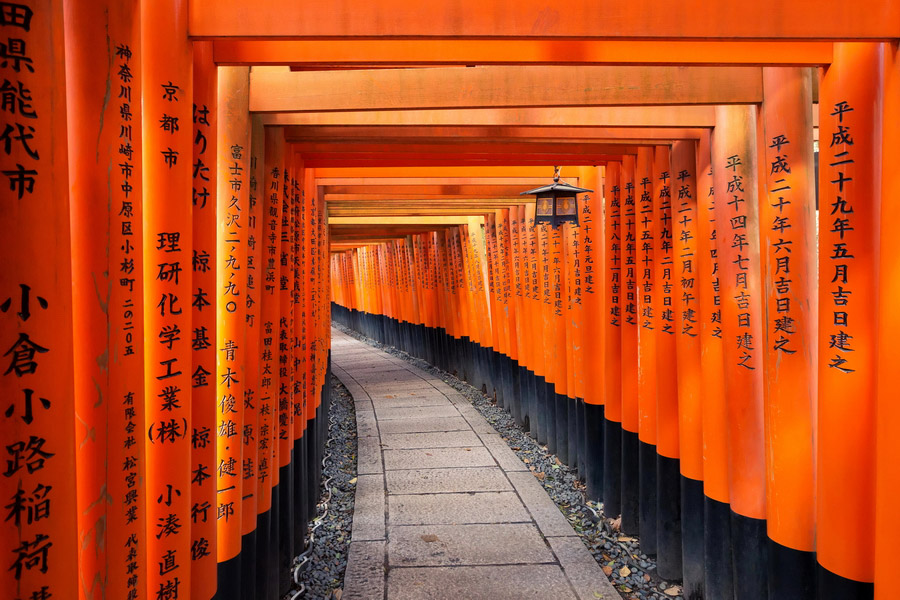
Shogun Tokugawa Ieyasu chose the small port town of Edo (the former name of Tokyo) as his new seat of power. Even then, Edo was already an important transport hub. From this moment began the eventful and complex history of Japan’s modern capital. As the city developed, by the early 18th century, Edo had become one of the most densely populated urban centers in the world, boasting around one million residents. For comparison, Paris at the start of the 18th century had roughly 600,000 inhabitants.
The Edo period lasted for more than two and a half centuries, during which Japan achieved remarkable heights in its economy, politics, and culture, while at the same time remaining almost entirely closed off from the outside world. This policy of national seclusion, which lasted from 1639 to 1853, is known in Japan as the Sakoku period (鎖国).
The Edo period can rightly be called one of the most fascinating eras in Japanese history, and here’s why:
This time is often described as a Golden Age in the nation’s history, largely thanks to the governance of the Tokugawa Shogunate. The shogunate maintained a strong central authority that ensured internal peace, upheld a stable social hierarchy, and fostered growth across all spheres of life, from the economy to culture. Urban life flourished as never before, giving rise to kabuki theater, the culture of geisha, and traditional tea houses (chashitsu).
Many prominent figures in Japanese literature and art lived during the Edo period. Among them was the celebrated poet Matsuo Basho (松尾芭蕉, 1644–1694), the most renowned figure in Japanese literature, famous for his succinct three-line haiku poetry. The artist Kitagawa Utamaro (1753–1806), known for his graceful portraits of Japanese women, would later influence European Impressionists and Post-Impressionists, including Van Gogh. In the late Edo period, the master Katsushika Hokusai (葛飾 北斎, 1760–1849) created his iconic woodblock print “The Great Wave off Kanagawa” (神奈川沖浪裏, 1823–1831), a work now recognized worldwide as a symbol of Japanese art.
5 Historical Facts About Feudal Japan
- The word “kamikaze”, which many today know mainly as the name for Japan’s World War II suicide pilots, was actually first used in the 13th century. When the Mongol fleet attempted to invade Japan, it was nearly obliterated by a powerful typhoon. The Japanese began to call this storm “kamikaze” (神風), meaning “divine wind”.
- During Japan’s feudal era, a strict code of conduct known as Bushido (武士道) was developed for the samurai class, becoming fully established by the 16th–17th centuries. One of its most severe rituals was the act of ritual suicide to preserve honor. Widely known as harakiri (腹切), it was more commonly referred to by samurai themselves as seppuku (切腹).
- In the Muromachi period, Japan saw the construction of some of its most iconic buildings. Among them is the Golden Pavilion (Kinkakuji, 金閣寺) in Kyoto, built in 1397, famous for its lavish exterior – the top two floors are entirely covered in real gold leaf. The same period also witnessed the building of the graceful Himeji Castle (姫路城), often called the “White Heron Castle” for its striking white appearance.
- During the Edo period, wealthy individuals and organizations began the custom of donating torii gates to Fushimi Inari-taisha (伏見稲荷大社) in Kyoto. These donations were made either in thanks for wishes that had been fulfilled or in hope of future blessings. Today, the shrine features more than 10,000 torii gates, creating its famous vivid orange tunnels.
- When geisha (芸者) first appeared in 17th-century Japan, they were actually men. The term “geisha,” which means “artist” in Japanese, is gender-neutral. These male performers, known as taikomochi (太鼓持), entertained guests with stories, music, and dramatic performances. Women began entering the profession in the 18th century and quickly replaced the men. Nowadays, the word “geisha” is associated almost exclusively with traditionally dressed, highly trained Japanese women.
Modern Japan (from 1868)
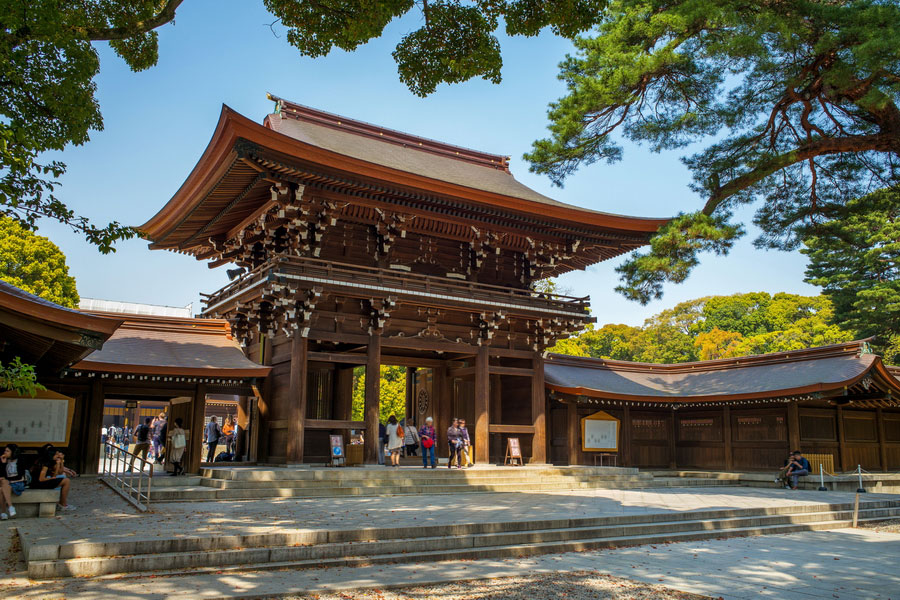
While the word “modern” often refers to events starting in the 20th century, in the context of Japanese history, modernity is generally considered to have begun in 1868. This was the year that marked the start of sweeping global reforms under Emperor Meiji (明治天皇, 1852–1912), ushering in a period of profound transformation. Japan’s modern era extends through the 20th century and continues into the most recent developments of the 21st century.
History of modern Japan from 1868 to 1950
This period in Japanese history was defined by the restoration of imperial rule and the founding of the Japanese Empire, which lasted from 1868 to 1947.
It is generally divided into several key stages:
- Meiji Period (明治時代, 1868–1912)
- Taisho Period (大正時代, 1912–1926)
- Early Showa Period (昭和, 1926–1945)
Meiji Period (明治, 1868–1912)
The first of these stages is known as the Meiji period (明治), a name that literally means “enlightened rule” or “bright governance”. This was no accident: after centuries of seclusion and economic isolation, Japan opened itself to the world, launching one of the most dynamic periods in its national development.
Timeline of the Meiji Restoration
- 1868 – Emperor Mutsuhito (睦仁) was crowned, taking the era name Meiji. With this, the shogunate was abolished and full power returned to the emperor. Meiji ruled until 1912.
- 1868 – The emperor’s residence was officially moved to the city of Edo, which was renamed Tokyo (東京), meaning “Eastern Capital”.
- 1871 – The yen (円) was introduced as Japan’s new currency. This year also saw the administrative reform that replaced feudal domains with the modern prefectural system.
- 1872 – The rigid social class system was formally abolished, granting equal legal rights to all citizens regardless of birth or status.
- 1860s–1870s – The zaibatsu (財閥) system emerged, as large industrial conglomerates such as Mitsubishi (三菱) rose to strategic importance. This system would continue to shape Japan’s economy well into the mid-20th century.
- 1894–1895 – First Sino-Japanese War, in which Japan defeated Qing China.
- 1904–1905 – Russo-Japanese War, marking the first time an Asian power defeated a European empire in modern warfare.
- 1875–1910 – An extraordinary period of imperial expansion, during which Japan annexed the Kuril Islands (1875), the Ryukyu Kingdom (1879), Taiwan (1895), and Korea (first as a protectorate in 1905, then fully annexed in 1910). Japan’s victories over China and Russia secured these acquisitions.
Overall, the history of the Meiji Restoration is seen as a decisive turning point that set Japan firmly on a capitalist path, shaping its future trajectory as a modern industrial and imperial power.
History of Japan before World War II
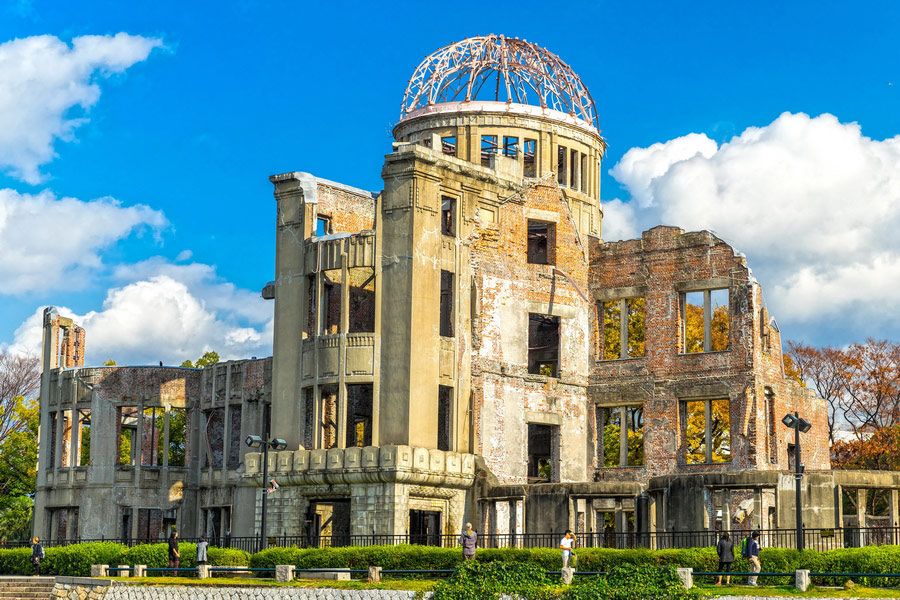
Throughout the Taisho period (1912–1926) and the early Showa period (1926–1945), Japan continued to strengthen its position by expanding the borders of its empire and waging wars with neighboring countries. The nation’s foreign policy during this time was marked by widespread militarization.
During World War I, Japan took part in military operations on the side of the Entente Powers. This involvement led to an increase in Japan’s overseas possessions and ushered in a period of rapid economic growth. However, by the early 1920s, Japan began to face serious challenges. The global economic crisis hit the country hard, triggering inflation and rising unemployment. Further compounding these difficulties, on September 1, 1923, an 8.3-magnitude earthquake – known to history as the Great Kanto Earthquake – struck Japan, devastating Tokyo and Yokohama, two of the country’s most vital cities, and deepening the national crisis.
In the 1930s, the Japanese government pursued a policy of intensified militarism and aggressive expansion abroad. In 1931–1932, Japan occupied Manchuria in northeastern China, provoking widespread international condemnation. This was followed by the outbreak of Japan’s Second War with China in 1937. In 1941, Japan entered World War II as an ally of Germany and Italy. Its attack on Pearl Harbor in Hawaii on December 7, 1941, which resulted in the deaths of more than 2,400 people, became the catalyst for the United States’ entry into the war.
The Tragedy of Hiroshima and Nagasaki
In August 1945, the most devastating event in Japan’s 20th-century history took place – the atomic bombings that obliterated the cities of Hiroshima (広島市) and Nagasaki (長崎市) and claimed the lives of more than 150,000 people.
The reason for the attacks was Japan’s refusal to accept the terms of the Potsdam Declaration of 1945, which demanded Japan’s unconditional surrender, the relinquishing of all territories it had seized since the late 19th century, and implicitly threatened the very institution of the emperor.
As a result, the United States dropped two nuclear bombs on Japan:
- A uranium bomb was dropped on Hiroshima on August 6, 1945. Approximately 80,000 people were killed instantly on that day.
- A plutonium bomb was dropped on Nagasaki on August 9, 1945. Although it was more powerful than the first, it caused slightly less destruction because it did not detonate over the city center. Even so, around 40,000 people died in the initial blast.
These attacks remain the first and only instances of nuclear weapons being used in war. The history of Hiroshima has since become a global symbol of the hope for a world free of nuclear arms. In the heart of the city stands the partially destroyed building that survived the explosion – the Genbaku Dome (原爆ドーム) – now preserved as a UNESCO World Heritage Site.
Following the bombings, Japan agreed to the terms of unconditional surrender, which Emperor Showa announced on August 15, 1945.
History of Japan after World War II
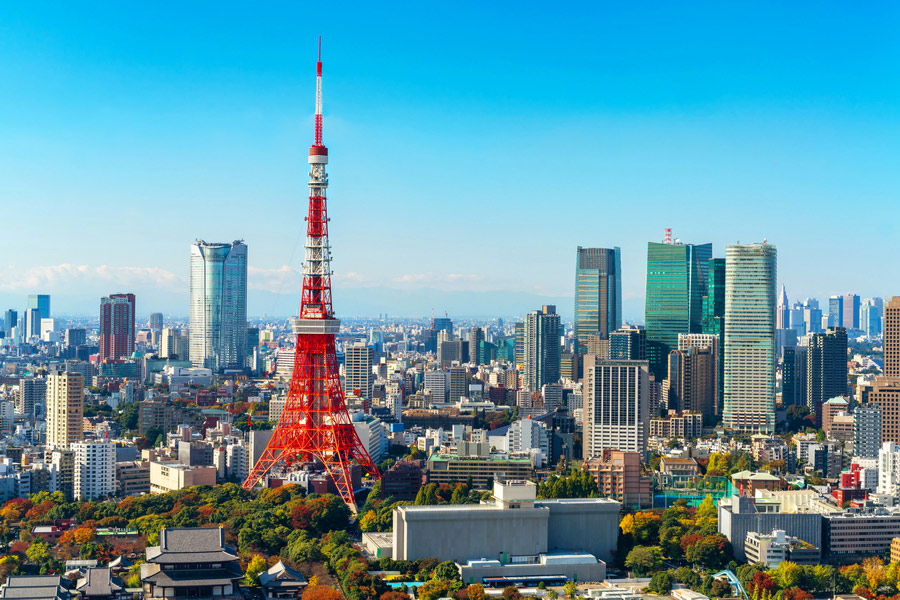
After the end of World War II, Emperor Hirohito (裕仁), who had ascended the throne in 1926, continued as emperor for many decades, reigning until 1989. His 62-year reign remains the longest in Japanese history.
Starting in 1947, Japan adopted an explicitly pacifist path, enshrined in its new constitution. The country’s prudent and balanced policies led to the so-called “Japanese economic miracle”, marked by extraordinary growth. By the mid-1970s, Japan had not only recovered from the devastation of war but had become the world’s second-largest economy, behind only the United States – a position it held until 2010, when it was overtaken by rapidly rising China.
Today, Japan is a constitutional monarchy, meaning it retains an emperor, but actual political power lies with the parliament (国会) and the prime minister. The current emperor is Naruhito (徳仁), who succeeded his father, Emperor Akihito (明仁), in 2019, after Akihito’s reign from 1989 to 2019. The current prime minister of Japan is Fumio Kishida (岸田 文雄), who has been in office since 2021.
Modern Japan: Interesting Facts
- As a consequence of its 1945 surrender, Japan lost about 95% of its pre-war territory. At its largest extent in the early 1940s, the Japanese Empire spanned more than 7 million km², roughly the size of Australia. After the war, Japan’s territory was reduced to the four main islands – Honshu, Hokkaido, Kyushu, and Shikoku – along with numerous smaller islands, totaling about 378,000 km².
- In modern Japan, innovative capsules have been developed to protect people from earthquakes and natural disasters. These are compact, highly durable spheres that can accommodate several individuals and be installed in private homes. Their popularity is easy to understand: Japan has experienced thousands of earthquakes in its history.
- Major earthquakes in the 20th and 21st centuries include the 1923 Great Kanto Earthquake near Tokyo (~7.9–8.2), the 1933 Sanriku earthquake and tsunami (8.4), the 1948 Fukui earthquake (7.1), and the 1995 Kobe earthquake (7.3), one of Japan’s most destructive modern disasters. The 2011 Great East Japan Earthquake (9.0) remains the most powerful in Japan’s recorded history. More recently, strong earthquakes struck Fukushima Prefecture in 2022 (7.3) and the Noto Peninsula in Ishikawa Prefecture in 2024 (7.6).
- Japan’s distinctive pop culture – especially anime, manga, and music – has become one of its most influential modern contributions to the world. While the history of Japanese animation dates back to the early 20th century, it was in the 21st century that original characters, diverse genres, and the playful kawaii (cute) culture truly captured global audiences.


